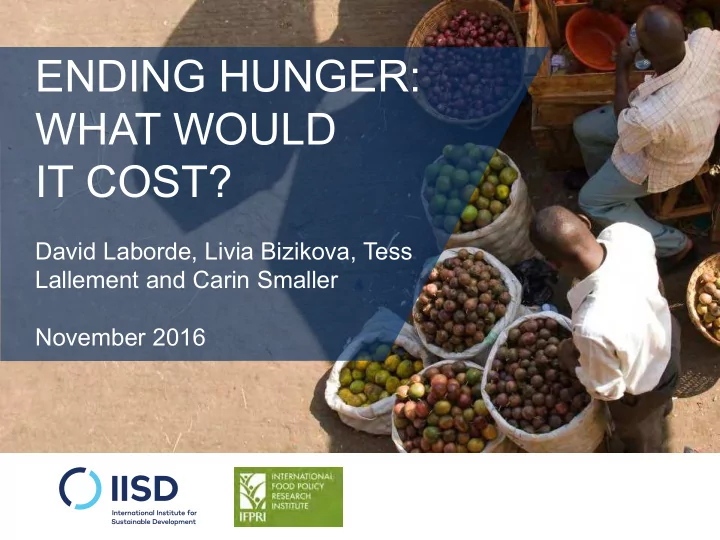

ENDING HUNGER: ENDING HUNGER: WHAT WOULD WHAT WOULD IT COST? IT COST? David Laborde, Livia Bizikova, Tess Lallement and Carin Smaller November 2016
THE METHODOLOGY
5 CATEGORIES OF SPENDING • Category I: Social safety nets Support to consumers through cash transfers and food stamps • Category II: Farm support Helping producers through fertilizer and seed subsidies, capital investments (e.g. tractors), R&D, improved technology, extension services and better organizing • Category III: Rural development Infrastructure, education, storage, market access and value chains • Category IV: Enabling policies Land reform, tax reform, trade and investment policies and institutional reform • Category V: Nutrition Addressing the global nutrition concerns, including stunting, exclusive breastfeeding, wasting, anemia, low birth weight, and overweight.
WHAT MODEL DO WE USE? MIRAGRODEP An innovative model that uses macroeconomic data with household level data • MIRAGRODEP is a computable general equilibrium (CGE) model that simulates national and international markets, taking into account production, demand and prices • The model relies upon household data to allow for a bottom-up approach • It is then matched with donor spending to calculate the donor share
ENDING HUNGER: DEFINITION • Household level threshold defined in terms of calories per capita (FAO threshold). • Country level goal: Target reached if 5% or less of the population hungry (FAO threshold).
WHAT DO WE PUT IN THE MODEL? A limited subset of interventions based on criteria: FARM RURAL SOCIAL • Interventions should DEVELOPMENT SUPPORT SAFETY NETS deliver bulk of the pay-off by 2030 • Food stamps • Capital • Rural infrastructure investment • Interventions should be (e.g. Tractors) • Rural relevant for donors Education • Technology • Interventions should • Fertilizer • Reduction in focus on food subsidies post-harvest consumption and/or losses • Extension production Services • Production subsidies
WHAT DO WE MISS AND WHY? Category IV: Enabling policies • Too difficult to put numbers into the model that accurately attribute spending on policy reform with increased calorie consumption Category V: Nutrition • The model does not directly cost nutrition, because the household data is incomplete • We are working with 1000 days, R4D and the World Bank who are trying to estimate the cost of ending malnutrition using a different model
HOW DO WE CALCULATE THE DONOR SHARE? STEP 1: co-funding rule Conduct an econometric analysis of donor support to developing country budgets. The analysis gives an external donor share by country and by level of GDP per capita. STEP 2: donor share The model defines the total cost of achieving SDG2. The co-funding rule is applied on an annual basis. The remaining costs are provided by domestic The share of donor money as a percentage of government taxes or loans. spending declines as a country develops
ENDING HUNGER IN SEVEN AFRICAN COUNTRIES
SEVEN COUNTRIES 52 million hungry people
CURRENT DONOR SPENDING IN THE 7 COUNTRIES: $1 BILLION/YR Category I: Food aid/food security programmes Category II: Agricultural education/training, agricultural financial services, agricultural inputs, agricultural research, agricultural services, food crop production, livestock/ veterinary services, livestock Category III: Agricultural cooperatives, rural development, rural infrastructure, agro-industries Category IV: Agricultural land resources, agricultural policy and management, agricultural water resources Category V: Basic nutrition Source: The Brookings Institute – Ending Rural Hunger
HUNGER IN 2030 IF NO EXTRA AID 67 Million
HOW MUCH EXTRA PUBLIC MONEY IS NEEDED TO END HUNGER IN THE SEVEN COUNTRIES? Annual average cost: $1 Billion
WHAT IS THE DONOR SHARE? HOW MUCH PRIVATE INVESTMENT IS GENERATED? Donor Annual Annual private share: average cost: investment generated $2.8 $400 $1 Million Billion Billion
WHO PAYS WHAT?
WHAT WOULD IT COST TO END HUNGER GLOBALLY?
HUNGER LEVELS IN 2015 & 2030 795 million Hungry people globally today
HOW DO WE ARRIVE AT A GLOBAL COST ESTIMATE? 1. Cluster countries together based on key variables (hunger, poverty, size of rural pop, etc...) 2. Estimate a per-capita average cost for each cluster type. 3. Estimate the global 2030 poverty and hunger level using macroeconomic projections at the country level. 4. Apply the per capita cost to get the total cost of ending hunger. 5. Apply our co-funding rule on a year-by-year basis at the country level
SO HOW MUCH EXTRA MONEY IS HOW MUCH EXTRA PUBLIC MONEY NEEDED TO END HUNGER? IS NEEDED TO END HUNGER? Annual average cost: $11 Billion
SO HOW MUCH EXTRA MONEY IS WHAT IS THE DONOR SHARE? NEEDED TO END HUNGER? Donor share: $4 Billion
SO HOW MUCH EXTRA MONEY IS HOW MUCH PRIVATE NEEDED TO END HUNGER? INVESTMENT IS GENERATED? Annual Annual average cost: Donor private investment share: generated: $11 $4 $5 Billion Billion Billion
ANNUAL GLOBAL DONOR SPENDING $4 Billion +3% $137 √ Increase Billion needed
WHERE SHOULD THE EXTRA MONEY GO?
To learn more visit: www.iisd.org/project/ending-hunger-what-would-it-cost Or contact : Carin Smaller: csmaller@iisd.org and Livia Bizikova: lbizikova@iisd.org
Recommend
More recommend